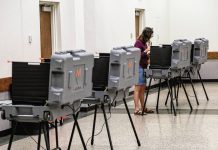Columbus North special education teacher Mary Hamlin sees herself as a salesperson.
Many of her high school students experience some degree of autism, a condition which interferes with their ability to interact socially with others, she said. Aside from struggling with some basic interactions, the 30 teenagers in her program don’t always understand the importance of education.
For these students, it is often a struggle to see past whatever activity currently holds their interest, Hamlin said.
So the 20-year educator spends much of her day selling everything from the value of homework to the importance of collaboration with other students.
For her work with students with disabilities, Hamlin was honored as Special Education Teacher of the Year by the Indiana Council for Exceptional Children during a Feb. 3 ceremony in Indianapolis.
Much of her Hamlin’s time is spent creating safe, comfortable environments where students can safely practice socializing without fear of judgment from their peers.
Outside of the classroom, she created a group called Columbuddies which works to provide students and parents with that social outlet.
The group spent time Thursday at Red Zone Laser Tag, an amusement venue northwest of the Flatrock River along U.S. 31.
Arcade games blink away in neons and pastels while an employee inflates a bounce castle, and two teenage boys jump around inside an enclosed trampoline.
Helen Milvert watches as Hamlin competes with student Courtney Barkes in a heated air hockey match.
Milvert’s daughter, Melissa, is a little overwhelmed by all the noise and activity. After a long day of school and doctor appointments, Melissa hides behind her mother, preferring to filter events from a safe distance.
“This really is one of my daughter’s favorite days of the week,” Milvert said.
Later, when the real laser tag begins, Melissa forgets her reticence and joins in.
“These are activities we don’t have access to otherwise,” Milvert said.
In such an environment, the youth don’t feel like special-needs students, Milvert said. Instead, they’re just teenagers having fun.
The majority of Hamlin’s students are on a traditional diploma track, learning in the same classes as their peers.
In the past, many special education students were allowed to graduate with non-diploma certificates. These documents usually indicated a less rigorous academic schedule and left many young people with limited employment options after high school, she said.
But these types of certificates are no longer allowed under state law, except in the most severe cases of physical and developmental disability — students who are completely non-communicative, mentally and physically unable to care for themselves.
Hamlin said the new emphasis on pushing students with disabilities to achieve a full diploma is fantastic.
“My students surprise me every day,” she said. “I have students with mild disabilities, and they’re not going to get a diploma. They’re going to earn a diploma.”
Changing approach
But Hamlin remembers a time, not so long ago, when treatment of students with disabilities was very different.She started her career with Muncie Community Schools in 1992. In those days, special education students were isolated into a separate school building. Corporal punishment was still a common technique for responding to challenging behavior among special education students. Her first principal even asked her to paddle a child who was acting up.“I think I cried more than the child did,” Hamlin said. “I never wanted to do that again.”
And she never has.
But, the disappearance of corporal punishment was only the first step down a long road toward better treatment for special education students, she said.
Even as special, separate school buildings closed and archaic practices such as paddling faded into the past, many districts still looked for ways to segregate special education students away from the general population, she said.
When Hamlin moved to Parkside Elementary School in Columbus in 1998, the school assigned most of its special education students to a separate wing of the building. While this was a vast improvement over conditions in Muncie, areas of the building in Columbus still held vestiges of an earlier era, she said.
One room, since removed, appeared to be nothing more than a storage closet with oddly-shaped walls. Its walls were covered in dense, hard rubber and the space was once intended to isolate and discipline special education students who exhibited aggressive or anti-social behavior, Hamlin said.
The space was never used, but for years it remained a reminder of how poorly special education students were once treated, she said.
Hamlin said she is glad to be part of a generation of educators that worked to rid the world of these archaic, often harmful practices.
Responding to needs
“So many behaviors are social and school is such a social-rich environment,” she said. “You have to have a much more positive response to student behaviors. Often, my students simply don’t understand social problems.”In most cases, punishment does nothing to help her students, she said. Instead, these kids need compelling, straightforward reasons to change their behavior.With activities such as laser tag, running around and exercising helps students manage emotional issues that arise from stressful social situations, said Amy Jackson, Hamlin’s teacher’s aide.
“You can’t move into the brass tacks of school work until those emotional needs are met,” Jackson said.
And that is where Hamlin excels as a special education teacher, her colleague said.
“I can’t think of anyone who does it better,” Jackson said. “She is the perfect balance of a level head, common sense and a great sense of humor.”
[sc:pullout-title pullout-title=”Mary Hamlin” ][sc:pullout-text-begin]
Age: 47
Education: Bachelor’s of education, Ball State University. Master’s of education, Indiana Wesleyan University.
Professional experience: Hamlin began her teaching career at Garfield Elementary School in Muncie in 1992. She moved to Parkside Elementary School in Columbus in 1998, then transferred to Columbus North High School in 2003.
[sc:pullout-text-end]




